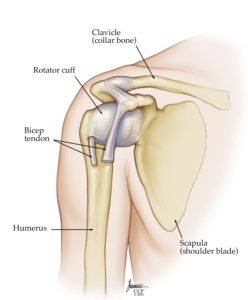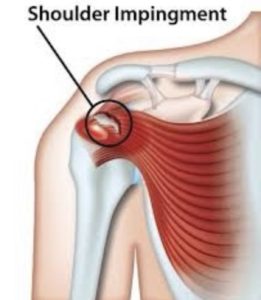. 2016 Sep;50(18):1124-34.
doi: 10.1136/bjsports-2015-095771.Epub 2016 Jun 10.
Effectiveness of physical therapy treatment of clearly defined subacromial pain: a systematic review of randomised controlled trials
- PMID: 27288517
- DOI: 10.1136/bjsports-2015-095771
Abstract
Aim: To summarise the current evidence regarding the effectiveness of physical therapy on pain, function and range of motion in individuals with subacromial pain syndrome (SAPS).
Design: Systematic review.
Data sources: PubMed, Web of Science, CINAHL, Cochrane, Embase, Lilacs, Ibecs and Scielo databases.
Eligibility criteria for selecting studies: Randomised controlled trials (RCTs) investigating physical therapy modalities for SAPS on pain, function/disability or range of motion were included.
Results: 64 high-quality RCTs were included. Exercise therapy provided high evidence of being as effective as surgery intervention and better than no treatment or placebo treatment to improve pain, function and range of motion in the short, mid and long terms. The combination of mobilisation and exercises provided high evidence to decrease pain and improve function in the short term. There is limited evidence for improvements on the outcomes with the isolated application of manual therapy. High level of evidence was synthesised regarding the lack of beneficial effects of physical resources such as low-level laser, ultrasound and pulsed electromagnetic field (PEMF) on pain, function or range of motion in the treatment of SAPS. There is limited evidence for microwave diathermy and transcutaneous electrical nerve stimulation. There is moderate evidence to no benefits with taping in the short term. Effects of diacutaneous fibrolysis and acupuncture are not well established yet.
Conclusions: Exercise therapy should be the first-line treatment to improve pain, function and range of motion. The addition of mobilisations to exercises may accelerate reduction of pain in the short term. Low-level laser therapy, PEMF and taping should not be recommended.
Keywords: Exercise rehabilitation; Scapula; Shoulder.
Published by the BMJ Publishing Group Limited. For permission to use (where not already granted under a licence) please go to http://www.bmj.com/company/products-services/rights-and-licensing/
CORE Physical Therapy in Omaha Explains…
By Dr. Mark Rathjen PT DPT CSCS
” Exercise therapy should be the first-line treatment to improve pain, function and range of motion. The addition of mobilisations to exercises may accelerate reduction of pain in the short term. Low-level laser therapy, PEMF and taping should not be recommended.” Quote from the above article.
Whats does this all mean to you?
This after 64 randomized controlled trials (The highest level of evidence) We clearly see a high evidence for the use of therapy and exercise by a qualified Doctor of Physical Therapy for shoulder pain and sub acromial pain.
Overall, joint mobilizations are shown to be also effective for pain and motion control, taping and laser are not effective. I won’t go into the effectiveness for Lower level light therapy and infrared therapy in this Blog. I will say that taping seems to have is place in rehab, but not for sub acromial pain. This study confirms that as well.
The exercise selections during rehab is important part for us at CORE Physical Therapy and Sports Performance. We can get you better, faster and more efficiently than any other rehab facility in town. Come and see the CORE difference. Proper selection of mobility, strengthening and corrective exercises will be the key to beating your pain.
C.O.R.E. Physical Therapy and Sports Performance PC,
At CORE Physical Therapy in Omaha, We specialize in the treatment of athletes. We have worked with athletes for a combined 30 years.
This is who are, This is what we do.
Owned and Operated
by
Dr. Mark Rathjen and Dr. Claire Rathjen.
CORE is a family owned business that has been
established in 2015
We are proud to serve the greater Omaha metro area.
For More information, Please feel free to contact us https://coreomaha.com/contact/
Please feel free to follow us at https://www.facebook.com/COREomaha/
To get started https://coreomaha.com/getting-started/
For more Blog information https://coreomaha.com/blog/
CORE Physical Therapy and Sports Performance PC.
17660 Wright St, suites 9/10
Omaha, NE 68130
402-933-4027
Youtube Account linked below.
https://www.youtube.com/channel/UCVg8OSN5h-i1n_ykw1Gvahg?view_as=subscriber


Similar articles
-
Clinical outcomes of a scapular-focused treatment in patients with subacromial pain syndrome: a systematic review.Br J Sports Med. 2017 Mar;51(5):436-441. doi: 10.1136/bjsports-2015-095460. Epub 2016 Jun 1.PMID: 27251897 Review.
-
Subacromial impingement syndrome–effectiveness of physiotherapy and manual therapy.Br J Sports Med. 2014 Aug;48(16):1202-8. doi: 10.1136/bjsports-2012-091802. Epub 2013 Nov 11.PMID: 24217037 Review.
-
Treatment of myofascial trigger points in common shoulder disorders by physical therapy: a randomized controlled trial [ISRCTN75722066].BMC Musculoskelet Disord. 2007 Nov 5;8:107. doi: 10.1186/1471-2474-8-107.PMID: 17983467 Free PMC article. Clinical Trial.
-
Is there evidence in favor of surgical interventions for the subacromial impingement syndrome?Clin J Sport Med. 2013 Sep;23(5):406-7. doi: 10.1097/01.jsm.0000433152.74183.53.PMID: 23989383
-
Manual therapy for the management of pain and limited range of motion in subjects with signs and symptoms of temporomandibular disorder: a systematic review of randomised controlled trials.J Oral Rehabil. 2015 Nov;42(11):847-61. doi: 10.1111/joor.12321. Epub 2015 Jun 7.PMID: 26059857 Review.
